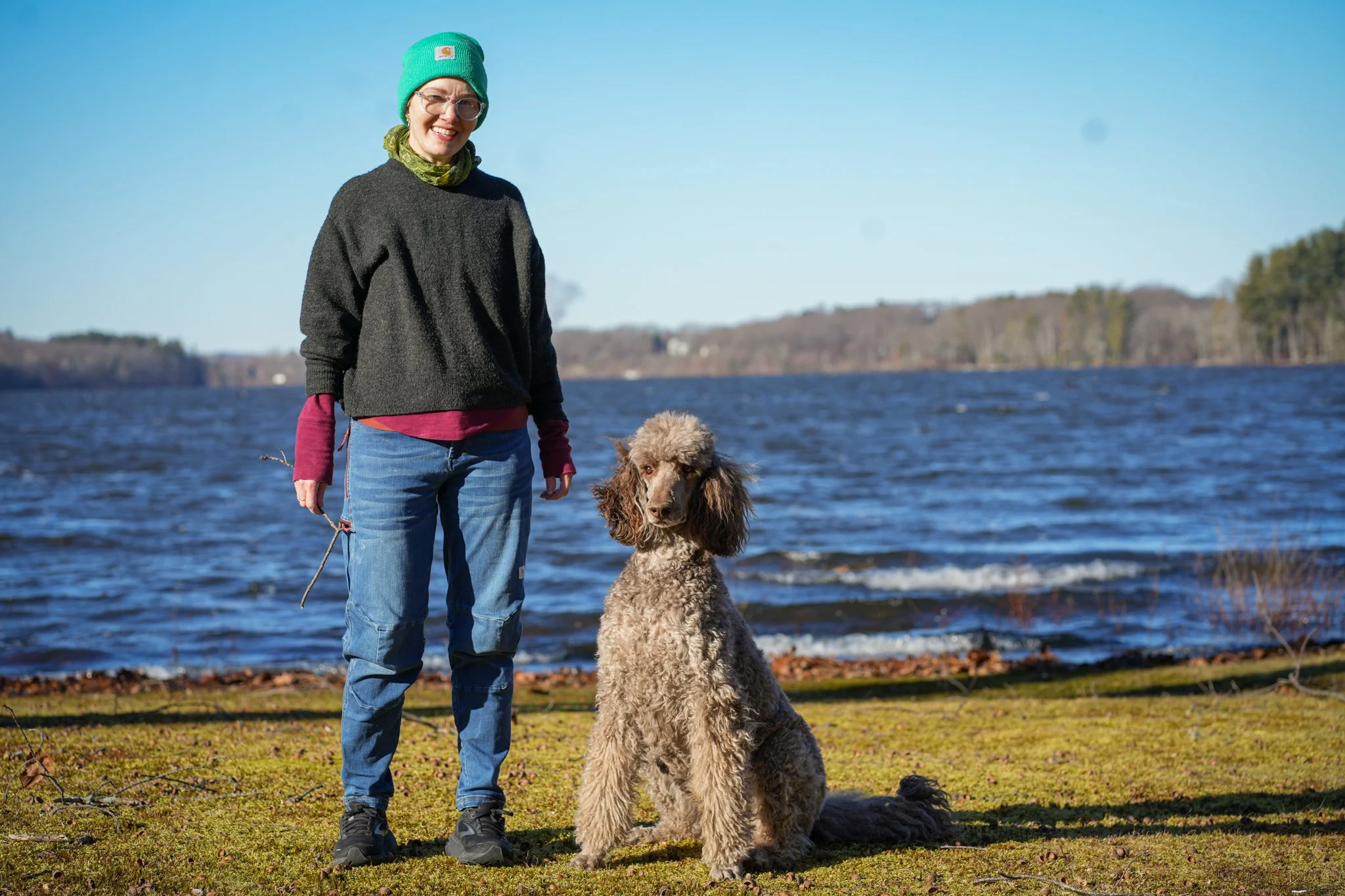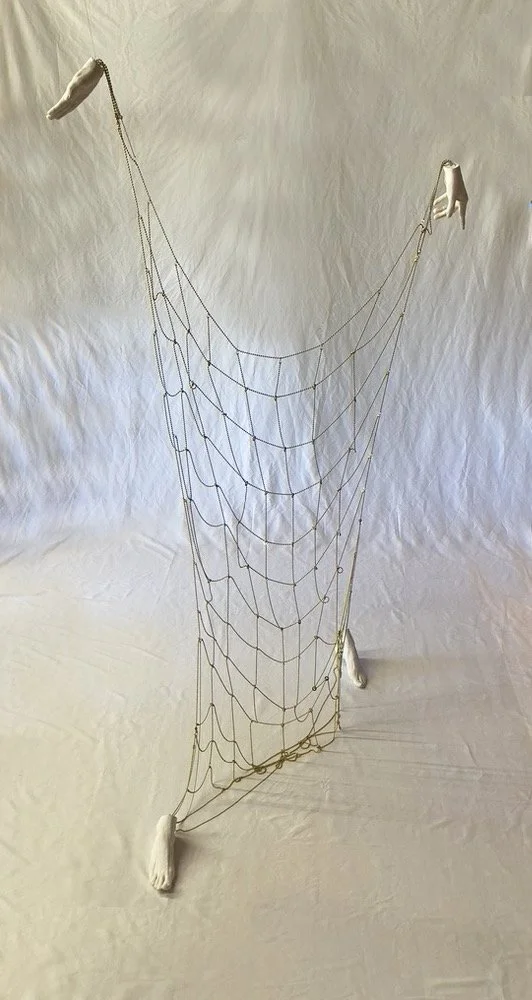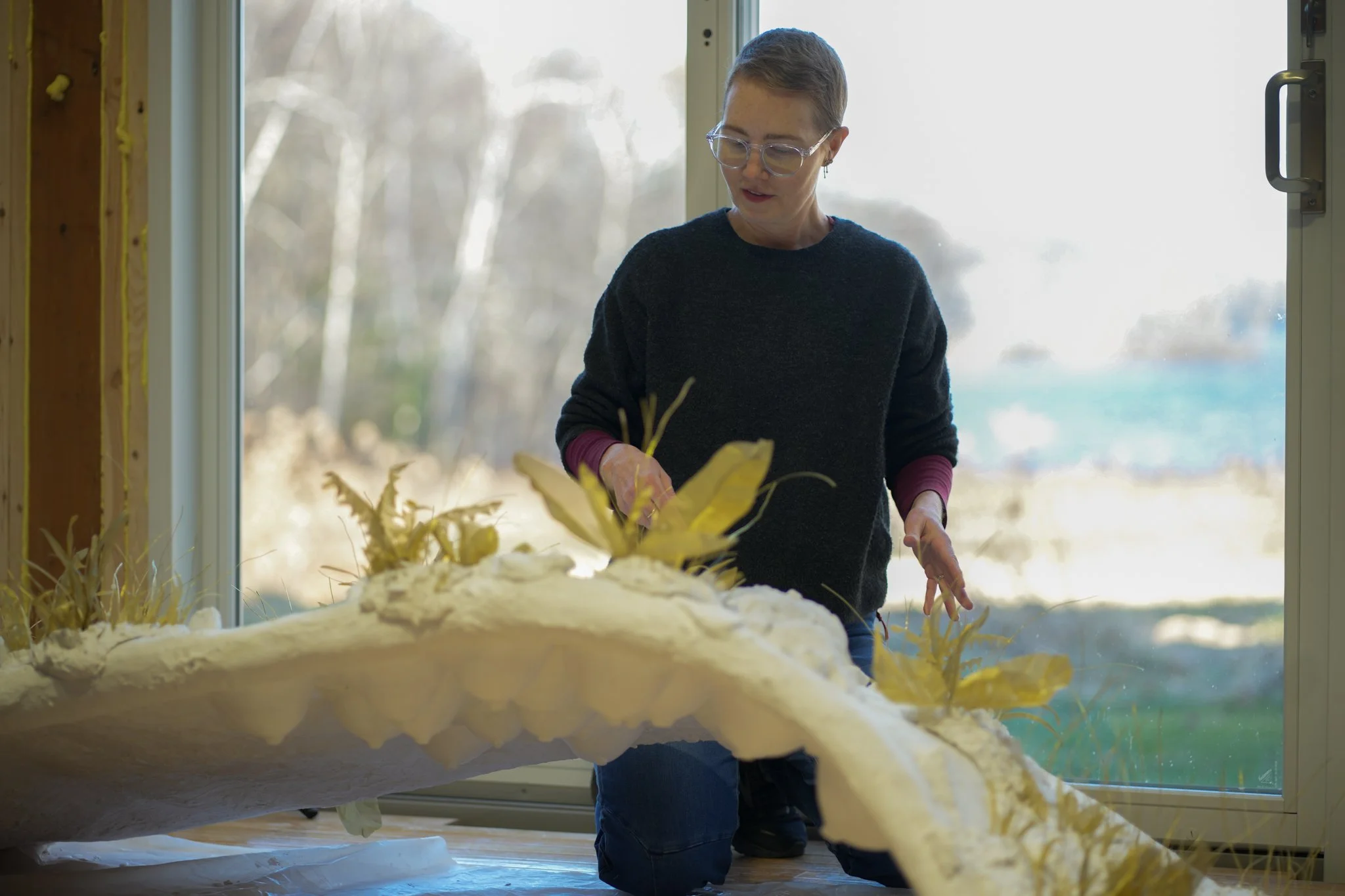Behind-the-scenes with artist Leah Piepgras
Leah Piepgras (b. 1970) received her MFA from Carnegie Mellon University in 1997 and has exhibited and performed throughout the United States. Her lush paintings and performative sculptures are meditations on time, humanity, and our place within the cosmos. Her work has been covered in Artsy, The New York Times, The Boston Globe, and will be featured in the Eagle-Tribune.
In preparation for her exhibition Parts and Pieces of the Universe, which opens at Essex Art Center on January 13, Executive Director Monica Lynn Manoski visited Leah at her home studio in North Andover. The sounds of construction punctuated their conversation; Leah and her husband Colin are converting a 1969 swinger's pad into their home and maker space. They settled into chairs surrounded by Leah's works in progress and Lazlo the dog—her unofficial studio assistant—at their side.
Leah Piepgras and her dog Lazlo confidently positioned near the edge of Lake Cochichewick.
Monica Lynn Manoski: Leah, you are prolific, and seeing so much of your work in one place is such a treat. Your work is informed by the study of physics, geology, anatomy, and paradox. Two paradoxes, in particular, shape your thinking. Can you tell us about them?Leah Piepgras: The coastline paradox says that all space and objects are infinite. For example, if you measure the perimeter of Lake Cochichewick with a yardstick, you'd come up with one measurement, but if you use millimeters or smaller units and measure the exact water line, it would be impossible–it would be infinite. I started thinking about measuring the body that way, and we become infinite as well.Infinite Body, 2021, plaster, brass, thread, 68 x 48 x 52 in
LP: The heap paradox considers when something becomes what it is. It originally refers to a heap of sand, asking how many grains of sand are necessary for it to be defined as a "heap." I love applying this idea to our physical existence and our human thinking. At what point are you sick? Or, a more enjoyable one to ponder—at what point do you fall in love? There is a moment of knowing, but getting to that is made up of tiny particulate matter. It's made up of smelling somebody, touching somebody. It's funny to make objects; the thing is really an idea. You're making something from parts and pieces and nothingness, and then it comes to be. When I'm making work there's just a moment of rightness. When it's really good work, you don't make that happen—it just happens—it's like it is born, not made.MLM: How often do you feel that? Are there particular pieces where you're like, this is it!LP: Artists are "making junkies." The euphoria we all chase happens when you decide something is done. I don't do drawings beforehand; I think that can be the death of something. If you think of an idea and then formulaically make it all the way through, you'll likely be sorry because you're not letting the beautiful things happen. When you're making something, you're a conduit for what's out there in the universe, and when you're lucky, you have the privilege of making something out of nothing.MLM: In Big Magic, author Elizabeth Gilbert talks about the importance of showing up and being ready because you never know when the moment of divine inspiration will strike.
LP: Yes, you've got to be present for it. I love thinking through material problems, like getting a certain texture or color or making something stand or bend without seeing a joint. These things entertain me for hours. When I was sick, I constructed stuff in my head. When I returned to my studio, what I made wasn't talking back to me. It took weeks of showing up daily, making a lot of bad stuff, and throwing it away.Leah at work on a new sculptural piece featuring the Earth Mother form, a recurring figure in her work.
MLM: You've mentioned sickness a few times. Since we first met, you've had a significant health issue that you're overcoming. Do you want to talk about that all?LP: I've been grappling with this and going back and forth. I want to step into it because it informs who I am and what I am making. At the same time, I always felt like making something so personal takes it away from being universal. MLM: Isn't the saying, "What is most personal is most universal?"LP: Right. Well, through my battle with anal cancer and having lived with Crohn's disease, I've realized how incredibly fragile we are. But aging and cell death are what make us human. The things that make us mortal allow us to feel alive.MLM: I recently heard Dave Asprey, the author of Super Human, describe how he's biohacking his life to live to be 180 years old. I don't know about you, but I don't want that! LP: Not me. Everyone you love will be dead. MLM: How does living near Lake Cochichewick in North Andover influence your practice? LP: Directly, by what washes up on the shore. I can't tell you how often I'll see something outside and rush out there—coat or no coat, shoes or no shoes—to see something amazing happening. I feel incredibly fortunate to have that relationship with the land. Looking at the same things daily, I notice subtleties and dramatic changes. MLM: Having recently brought my first child into the world, I've clung to your works connected to motherhood. I love how you present the idea of the Earth mothering us. Can you talk about this more?Earth Mother, 2022, Gold leaf and acrylic on Tyvek, 48 x 32 in
LP: I feel grounded and taken care of in nature. It's easy to get caught up in daily life, but when I'm outside, I experience wonder and gratitude. I also think of mothering in terms of working with materials. I think about the labor of making stuff—labor is a way to sit with yourself and your ideas and work through something. As mothers, you do a lot of labor, and sometimes it's mundane, like folding baby onesies and socks.(laughter)MLM: Yes, I am forever folding…and buying new socks because they disappear! LP: Oh my gosh, I know. When I'm gluing mirrors or casting hundreds of the same thing over and over—in that space of repetition and sameness—you can see and reflect on something else. I like repetition; it can be a powerful way to notice small stuff.MLM: Another thing that we've talked about before is this idea of family trauma. Is that something you want to get into at all? LP: I think we've all experienced trauma in our lives to various degrees. The Dividing Line is a piece that allowed me to work through something. The rope I made is the circumference of a particular room. The piece allowed me to turn time into an object.Dividing Line, 2017- 2021, performative sculpture, 57 ft long hand-made cotton rope, bed sheets, dye
LP: I don't keep a sketchbook, but I keep images, drawings, and texts on notecards in a box. I've been thinking about many of the same things for years—ever since childhood. But each time you return to them, you see them differently.MLM: Yes, my colleague Gabriel was recently interviewed for WBUR, and during the conversation, he was looking back at the work he made when he was five years old. It's interesting to hear him talk about the throughlines. His work looks different now and is more sophisticated, but it's the same in many ways.
LP: I think you come with this knowledge that's yours—or knowledge of the universe that is embodied in you—and these are the things that you grapple with for your whole existence.
MLM: Yes, that is beautiful—your life's work. One last thing that I'm hoping you can share—What thoughts, feelings, or conversations do you hope might be sparked by folks viewing your show?
LP: I don't have anything specific in mind, but I hope that I make things that are generous and don't require you to read a wall label to experience some wonder, feeling, or sensation.
MLM: From the scale of your works to your ability to traverse different mediums so gracefully, there's so much to be mesmerized by. Looking at the works on the wall behind you now, you can get lost in the paintings, searching for imagery, meaning, and connection. The layering is so rich.Our Souls at Night, 2016, acrylic on panel, 78.5 x 27.5 in
LP: Thank you. I don't have to have a show to create, but it is way more fun when you think about how the pieces communicate with each other, and I'm looking forward to learning what the Essex Art Center community sees in the work.MLM: I can't wait for our community to immerse themselves in your work. Leah's show opens at 6:00 PM on Saturday, January 13, 2024, and runs through March 2, 2024. Please come see it!






